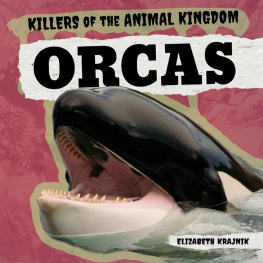Published in 2020 by The Rosen Publishing Group, Inc.
29 East 21st Street, New York, NY 10010
Copyright 2020 by The Rosen Publishing Group, Inc.
All rights reserved. No part of this book may be reproduced in any form without permission in writing from the publisher, except by a reviewer.
First Edition
Editor: Elizabeth Krajnik
Book Design: Reann Nye
Photo Credits: Cover Grafissimo/E+/Getty Images; pp. 4, 5, 15, 21 Tory Kallman/Shutterstock.com; p. 6 wildestanimal/ Shutterstock.com; p. 7 Greg Schneider/birdphotographer.ca/Moment/Getty Images; p. 9 Foto 4440/Shutterstock.com; p. 10 MR1805/iStock / Getty Images Plus/Getty Images; pp. 11, 12 Monika Wieland Shields/Shutterstock.com; p. 13 Agami Photo Agency/Shutterstock.com; p. 14 Mike Korostelev www.mkorostelev.com/Moment/Getty Images; p. 17 Neirfy/Shutterstock.com; p. 18 nodff/Shutterstock.com; p. 19 Ingus Kruklitis/Shutterstock.com; p. 20 Lazareva/iStock / Getty Images Plus/Getty Images; p. 22 Christian Musat/Shutterstock.com.
Cataloging-in-Publication Data
Names: Krajnik, Elizabeth.
Title: Orcas / Elizabeth Krajnik.
Description: New York : PowerKids Press, 2020. | Series: Killers of the animal kingdom| Includes glossary and index.
Identifiers: ISBN 9781725306172 (pbk.) | ISBN 9781725306196 (library bound) | ISBN 9781725306189 (6pack)
Subjects: LCSH: Killer whale--Juvenile literature.
Classification: LCC QL737.C432 K73 2020 | DDC 599.536--dc23
Manufactured in the United States of America
CPSIA Compliance Information: Batch #CSPK19. For Further Information contact Rosen Publishing, New York, New York at 1-800-237-9932.
KILLER WHALES
Orcas, which are commonly called killer whales, arent actually whales. Theyre the largest members of the dolphin family. However, these giant mammals are one of the most powerful predators on Earth. Orcas are very smart and have a number of adaptations that make them such good killers.
Over the years, orcas have gotten a bad reputation for killing people. However, orca attacks have only happened in cases of orcas held in captivity. Wild animals arent meant to live in captivity and, as a result, orcas are sometimes misunderstood and feared. Read on to learn the truth about these skilled predators.

Orcas may breach, or leap out of the water, for a number of reasons, including to communicate with other orcas and also as a form of play.
ORCA BASICS
Orcas have black bodies with white bellies, white parts near their eyes, and a gray part behind their dorsal fin. Male orcas weigh up to 11.02 tons (10 mt) and can be as long as 30 feet (9.1 m). Their dorsal fin can be as tall as 6.5 feet (2 m) high.
KILLER FACTS
In the wild, male orcas live an average of 30 years and females live an average of 46 years. Captive orcas in the United States only live an average of 12 years.


The San Juan Islands in Washington State are a great place to see orcas in the wild from late May to mid-October.
Female orcas weigh up to 8.3 tons (7.5 mt) and can be as long as 27.8 feet (8.5 m). Their dorsal fin is about half the height of male dorsal fins. Orca babies, which are called calves, can weigh up to 400 pounds (181 kg) and are about 7.8 feet (2.4 m) long at birth.
ON THE HUNT
Orcas are apex predators, which means they have no natural predators and are at the top of the food chain. They eat fish, penguins, seals, sea lions, whales, squid, and sea birds. Orcas hunt as a pod, or family group. Pods vary in size but may have as many as 40 members.
Pods use different hunting methods to catch their prey. To catch seals on pieces of ice, orcas swim together to make a wave. Then, they swim under the piece of ice and push the wave with their tails. The water pushes the seal off the ice, allowing the orcas to attack.
KILLER FACTS
When orcas hunt large prey, such as whales, they often go after young or weak animals. They swim into, bite, and pull on their prey to wear it down.

Some orcas living off the coast of Patagonias Valdes Peninsula purposely go up on the pebbled beach to catch sea lions. They are the only group of orcas known to do this.
POD COMMUNICATION
To hunt, orca pods have to communicate well. Orcas make a number of sounds to communicate with their pods. Some of these sounds are unique to members of their pod and can be understood from far away. Different pods may share some of the same sounds. However, no two pods use exactly the same sounds all the time.


The sounds orcas make is one way they keep track of where the pods members are. Most orcas stay within hearing range of their pod.
Scientists have found that orcas make three sounds: clicks, whistles, and pulsed calls. Orcas learn these sounds and pass them down from mother to child. Calves dont know many sounds when theyre born, but they learn more sounds as they get older.
KILLER CALVES
Orcas usually have babies once every three to five years. However, some orcas may only have a calf once every 10 years. Orcas carry their babies for 17 months on average. They usually give birth to one calf at a time. Calves are born in the water and usually come out of their mother tail first. However, some calves have been born head first.

Calves swim next to their mother to save energy. If they didnt, they might not be able to keep up with the rest of the pod.
At birth, orca calves have a soft dorsal fin and tail flukes, which stiffen over time. The white parts of orca calves may look more like pale yellow or tan until the end of the first year. Calves drink their mothers milk for about a year.
ORCAE COTYPES
Scientists have found different types of orcas, called ecotypes. Orcas belonging to different ecotypes are different sizes, look different, eat different prey, have different communicative sounds, and act differently. Scientists can tell these ecotypes apart by where they live.




















